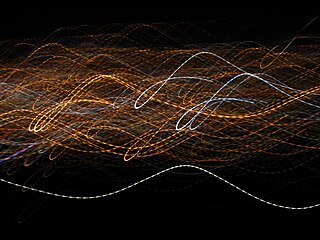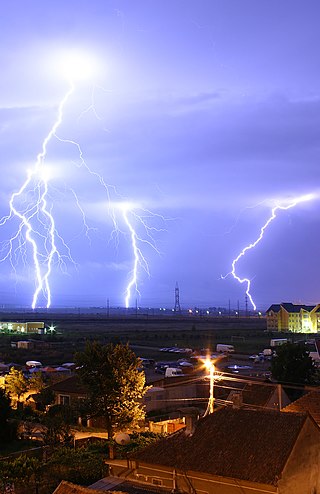Related Research Articles

A linear particle accelerator is a type of particle accelerator that accelerates charged subatomic particles or ions to a high speed by subjecting them to a series of oscillating electric potentials along a linear beamline. The principles for such machines were proposed by Gustav Ising in 1924, while the first machine that worked was constructed by Rolf Widerøe in 1928 at the RWTH Aachen University. Linacs have many applications: they generate X-rays and high energy electrons for medicinal purposes in radiation therapy, serve as particle injectors for higher-energy accelerators, and are used directly to achieve the highest kinetic energy for light particles for particle physics.

A pulse-forming network (PFN) is an electric circuit that accumulates electrical energy over a comparatively long time, and then releases the stored energy in the form of a relatively square pulse of comparatively brief duration for various pulsed power applications. In a PFN, energy storage components such as capacitors, inductors or transmission lines are charged by means of a high-voltage power source, then rapidly discharged into a load through a high-voltage switch, such as a spark gap or hydrogen thyratron. Repetition rates range from single pulses to about 104 per second. PFNs are used to produce uniform electrical pulses of short duration to power devices such as klystron or magnetron tube oscillators in radar sets, pulsed lasers, particle accelerators, flashtubes, and high-voltage utility test equipment.

In fusion power research, the Z-pinch is a type of plasma confinement system that uses an electric current in the plasma to generate a magnetic field that compresses it. These systems were originally referred to simply as pinch or Bennett pinch, but the introduction of the θ-pinch concept led to the need for clearer, more precise terminology.

The Z Pulsed Power Facility, informally known as the Z machine or Z, is the largest high frequency electromagnetic wave generator in the world and is designed to test materials in conditions of extreme temperature and pressure. It was originally called the PBFA-II and was created in 1985. Since its refurbishment in October 1996 it has been used primarily as an inertial confinement fusion (ICF) research facility. Operated by Sandia National Laboratories in Albuquerque, New Mexico, it gathers data to aid in computer modeling of nuclear weapons and eventual fusion pulsed power plants.

A Marx generator is an electrical circuit first described by Erwin Otto Marx in 1924. Its purpose is to generate a high-voltage pulse from a low-voltage DC supply. Marx generators are used in high-energy physics experiments, as well as to simulate the effects of lightning on power-line gear and aviation equipment. A bank of 36 Marx generators is used by Sandia National Laboratories to generate X-rays in their Z Machine.

Aneutronic fusion is any form of fusion power in which very little of the energy released is carried by neutrons. While the lowest-threshold nuclear fusion reactions release up to 80% of their energy in the form of neutrons, aneutronic reactions release energy in the form of charged particles, typically protons or alpha particles. Successful aneutronic fusion would greatly reduce problems associated with neutron radiation such as damaging ionizing radiation, neutron activation, reactor maintenance, and requirements for biological shielding, remote handling and safety.

In an electric circuit, instantaneous power is the time rate of flow of energy past a given point of the circuit. In alternating current circuits, energy storage elements such as inductors and capacitors may result in periodic reversals of the direction of energy flow. Its SI unit is the watt.

A pinch is the compression of an electrically conducting filament by magnetic forces, or a device that does such. The conductor is usually a plasma, but could also be a solid or liquid metal. Pinches were the first type of device used for experiments in controlled nuclear fusion power.
Breaking capacity or interrupting rating is the current that a fuse, circuit breaker, or other electrical apparatus is able to interrupt without being destroyed or causing an electric arc with unacceptable duration. The prospective short-circuit current that can occur under short circuit conditions should not exceed the rated breaking capacity of the apparatus, otherwise breaking of the current cannot be guaranteed. The current breaking capacity corresponds to a certain voltage, so an electrical apparatus may have more than one breaking capacity current, according to the actual operating voltage. Breaking current may be stated in terms of the total current or just in terms of the alternating-current (symmetrical) component. Since the time of opening of a fuse or switch is not coordinated with the reversal of the alternating current, in some circuits the total current may be offset and can be larger than the alternating current component by itself. A device may have different interrupting ratings for alternating and direct current.

A variety of types of electrical transformer are made for different purposes. Despite their design differences, the various types employ the same basic principle as discovered in 1831 by Michael Faraday, and share several key functional parts.
A linear transformer driver (LTD) within physics and energy, is an annular parallel connection of switches and capacitors. The driver is designed to deliver rapid high power pulses. The LTD was invented at the Institute of High Current Electronics (IHCE) in Tomsk, Russia. The LTD is capable of producing high current pulses, up to 1 mega amps (106 ampere), with a risetime of less than 100 ns. This is an improvement over Marx generator based pulsed power devices which require pulse compression to achieve such fast risetimes. It is being considered as a driver for z-pinch based inertial confinement fusion.

ATLAS-I, better known as Trestle, was a unique electromagnetic pulse (EMP) generation and testing apparatus built between 1972 and 1980 during the Cold War at Sandia National Laboratories near Kirtland Air Force Base in Albuquerque, New Mexico.

Magnetized liner inertial fusion (MagLIF) is an emerging method of producing controlled nuclear fusion. It is part of the broad category of inertial fusion energy (IFE) systems, which drives the inward movement of fusion fuel, thereby compressing it to reach densities and temperatures where fusion reactions occur. Previous IFE experiments used laser drivers to reach these conditions, whereas MagLIF uses a combination of lasers for heating and Z-pinch for compression. A variety of theoretical considerations suggest such a system will reach the required conditions for fusion with a machine of significantly less complexity than the pure-laser approach. There are currently at least two facilities testing feasibility of the MagLIF concept, the Z-machine at Sandia Labs in the US and Primary Test Stand (PTS) located in Mianyang, China.

Leopoldo Soto Norambuena is a Chilean Physicist born in Santiago, Chile, on October 14, 1964. His publication appears with the name Leopoldo Soto or L. Soto. He works at the Comisión Chilena de Energía Nuclear where he founded the Plasma Physics and Nuclear Fusion Laboratory. His main contributions are in experimental physics. The group that he created and leads is a pioneer in the miniaturization of dense plasma focus devices which can reproduce, on a scale basis, similar physics as the ones obtained in large devices which are only available in large laboratories of the world. Due to Soto's contributions, it is possible to develop relevant research in dense transient plasmas using small devices.
Thomas W. L. "Tom" Sanford is an American plasma physicist who developed a multi-wire array for use in a pulsed Z-pinch plasma system which resulted in a breakthrough for inertial confinement fusion (ICF) research. In 2005, he was awarded the Hannes Alfvén Prize with Malcolm Haines and Valentin Smirnov for his contributions to the field.
Malcolm Golby Haines was a British plasma physicist known for his research on Z-pinches. He was a Fellow of the American Physical Society and was co-awarded the 2005 Hannes Alfvén Prize.
The history of nuclear fusion began early in the 20th century as an inquiry into how stars powered themselves and expanded to incorporate a broad inquiry into the nature of matter and energy, as potential applications expanded to include warfare, energy production and rocket propulsion.
Christine Anne Coverdale is an American plasma physicist at Sandia National Laboratories, where she is a Distinguished Member of the Technical Staff.
Zap Energy is an American company that aims to commercialize fusion power through use of a sheared-flow-stabilized Z-pinch. The company is based near Seattle with research facilities in Everett and Mukilteo, Washington. The company aims to scale their technology to maintain plasma stability at increasingly higher energy levels, with the goal of achieving scientific breakeven and eventual commercial profitability.
References
- 1 2 Mitchell, I.H.; Bayley, J.M.; Chittenden, J.P.; Worley, J.F.; Dangor, A.E.; Haines, M.G. (1996). "A high impedance mega-ampere generator for fiber z-pinch experiments". Review of Scientific Instruments. Vol. 67. doi:10.1063/1.1146884.(subscription required)
- ↑ Mitchell, I.H.; Bayley, J.M.; Chittenden, J.P.; Choi, P.; Worley, J.F.; Dangor, A.E.; Haines, M.G. (1994). "The MAGPIE Generator". AIP Conference Proceedings. Vol. 299. doi:10.1063/1.2949195.(subscription required)
- ↑ Suzuki-Vidal, F. A., "Experimental study of radiatively cooled magnetically driven plasma jets", PhD Thesis, Imperial College London, 2009.
- ↑ Remington, B.A., Drake, R.P., Ryutov, D.D, "Experimental astrophysics with high power lasers and Z pinches", Reviews of Modern Physics, Vol. 78, pp.782-784, July–September 2006.
- ↑ Z machine homepage, Sandia National Laboratories